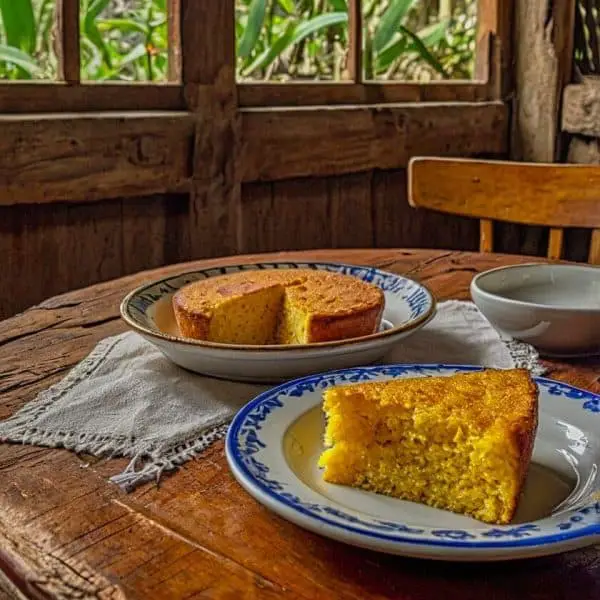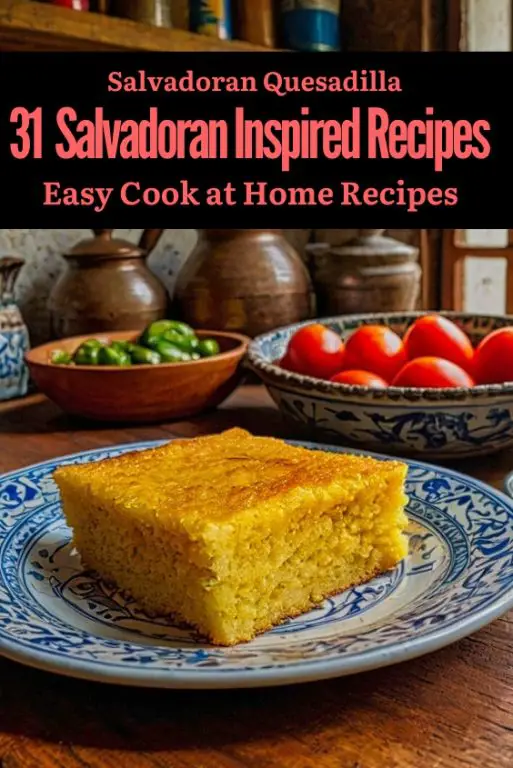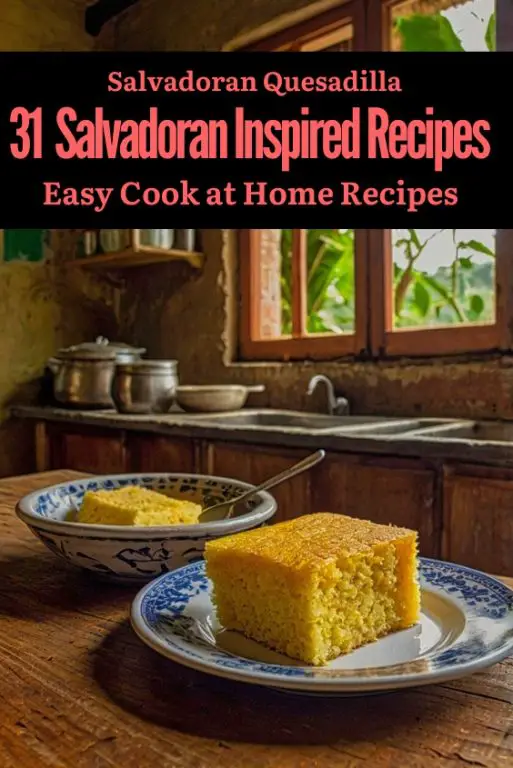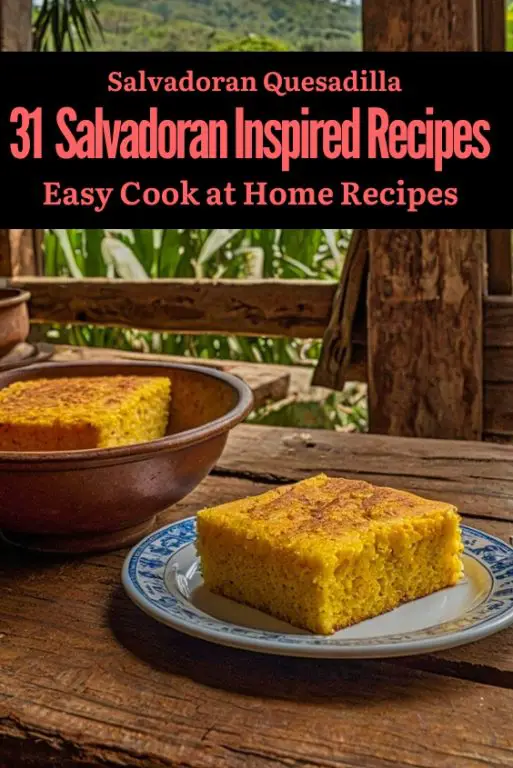The Salvadoran Quesadilla recipe is a sweet bread served with coffee. It is traditionally soft and cake-like in texture and full of flavor but requires specific cooking techniques. One technique is to cream the butter and sugar. This makes a light and fluffy base for the batter, needed for the soft crumb. Then sift the dry ingredients: baking powder and rice flour. Note that the quesidilla in El Salvador is a kind of cake that is different from the Mexican version.
The recipe looks easy but you can make these mistakes when making the Salvadoran Quesadilla recipe. A common error is to overmix the batter, which results in a thicker texture. Mix until ingredients are combined to keep it light and airy. Another mistake is making the wrong measurements – especially with the cheese – which can ruin the flavor balance. Also, baking the quesadilla too long can make the top brown too fast, leaving the inside undercooked.
Proper kitchen equipment is essential for this recipe. Cream the butter and sugars using a stand mixer. A sifter is also needed to mix in the dry ingredients. A greased baking pan will also stop the quesadilla from sticking and produce the traditional golden crust. Lastly, a wire cooling rack helps keep the quesadilla evenly cool without getting soggy on the bottom.
In case you know how to use proper techniques, avoid common mistakes and have the equipment needed to make this authentic Salvadoran Quesadilla recipe, you can make this dish with ease.
Ingredients For the Salvadoran Quesadilla Recipe
Queso Fresco or Farmer’s Cheese
Sweetened Condensed Milk
Eggs
Melted Unsalted Butter
Cornstarch
Baking Powder
Vanilla Extract
Salt
Raisins
Cooking Instructions For the Salvadoran Quesadilla Recipe
- Preheat the oven to 350°F (180°C). Grease a 9-inch round cake pan with butter or cooking spray.
- In a large mixing bowl, crumble the queso fresco or farmer’s cheese into small pieces.
- Add the sweetened condensed milk and mix until well combined.
- Beat the eggs in a separate bowl and add them to the cheese mixture, stirring until smooth.
- Stir in the melted butter, cornstarch, baking powder, vanilla extract, and salt. Mix until well combined and smooth.
- Add the raisins (optional) and stir until evenly distributed.
- Pour the mixture into the prepared cake pan and smooth out the top with a spatula.
- Bake for 45-50 minutes or until the edges are golden brown and a toothpick inserted in the center comes out clean.
- Allow the cake to cool for 10-15 minutes before slicing and serving.
10 Ways to Eat Healthy in El Salvador
1. Select Fresh Fruits
El Salvador is filled with tropical Fruits like mangoes, papayas, bananas and pineapples. Additions of fresh fruit to your diet provide vitamins, fibre and antioxidants while enjoying the natural sweetness of local produce.
2. Consume More Beans
Beans are a staple in Salvadoran cuisine and an excellent source of plant based protein, fibre and minerals (magnesium and iron). Soups, rice or stuffed pupusas are other ways beans provide a filling meal and a source of energy.
3. Grilled Meats
In place of fried foods go for Grilled meats like Grilled chicken or carne asada. Grilling eliminates some added fat and is a balanced meal when paired with fresh veggies or a side of beans and rice.
4. Enjoy Fresh Salads
Salvadoran meals often feature Fresh Salads made with local vegetables. Including these in your plate gives you fibre, vitamins and minerals. For a nutritious side, eat salads with tomatoes, avocados and cucumbers.
5. Limit Fried Foods
While Fried Foods like Fried yuca and plantains are tasty, baked or grilled versions may be healthier. You can still get these foods without the extra oil and calories from frying.
6. Choose Whole Grains
When eating rice, choose brown rice over white rice if available. Brown rice has more fibre and nutrients so you feel full longer. Whole grains help with digestion and regulating blood sugar.
7. Go for Light Soups
Soups are a staple in Salvadoran cuisine, and traditional ones such as sopa de gallina or sopa de res contain vegetables and lean meats. Soups made from broth are lighter and more filling – without the extra calories.
8. Incorporate Seafood
El Salvador has long coastline and fresh Seafood is plentiful. Fish and shellfish offer lean protein and omega 3 essential fatty acids which help heart health. Grilled or steamed seafood dishes are healthy options.
9. Snack on Nuts and Seeds
Local Nuts and seeds such as cashews or pumpkin Seeds are healthy snacks. These snacks are full of good fats, fibre and protein – a great snack option to fill you up in between meals.
10. Drink Fresh Juices
Fresh fruit Juices are popular in El Salvador but can be high in sugar. Enjoy them moderately and choose whole fruits when possible. Or go with water or agua fresca (light fruit juice in water), a refreshing low-sugar drink.
FAQ For the Salvadoran Quesadilla Recipe
Q: What ingredients are essential for a traditional Salvadoran Quesadilla recipe?
A: A traditional Salvadoran Quesadilla recipe requires several key ingredients that contribute to its unique flavor and texture. The base of the quesadilla is typically made with rice flour or corn flour, which gives it a slightly dense but moist consistency. Additionally, you’ll need ingredients like cheese, usually a soft white cheese such as queso fresco, along with sugar to add sweetness, and eggs for binding. Some recipes may also include baking powder to create a lighter texture. When combined, these elements result in a deliciously sweet and cheesy treat that is a beloved staple in Salvadoran cuisine.
Q: How do you serve a Salvadoran Quesadilla recipe to make it more appealing?
A: To serve a Salvadoran Quesadilla recipe in an appealing way, consider slicing it into wedges or squares for easy sharing. You can dust the top with powdered sugar or serve it alongside a drizzle of condensed milk for added sweetness. Additionally, garnishing the plate with fresh fruits such as mango or strawberries can add a pop of color and freshness that enhances the overall presentation. Offering a side of coffee or hot chocolate also complements the quesadilla, creating a delightful dessert experience. These serving suggestions elevate the Salvadoran Quesadilla recipe, making it not only tasty but visually inviting as well.
Q: Can a Salvadoran Quesadilla recipe be made ahead of time for special occasions?
A: Yes, a Salvadoran Quesadilla recipe can be made ahead of time, making it an excellent choice for special occasions or gatherings. You can prepare the batter and bake the quesadillas a day in advance, allowing them to cool completely before storing them in an airtight container. When ready to serve, simply reheat them in the oven until warmed through, which helps maintain their soft texture. Preparing the quesadillas ahead of time not only saves you time on the day of the event but also allows the flavors to develop, making them even more enjoyable for your guests.
Q: How do you adapt a Salvadoran Quesadilla recipe for dietary restrictions?
A: Adapting a Salvadoran Quesadilla recipe for dietary restrictions can be done easily with a few substitutions. For a gluten-free version, you can use gluten-free rice flour or a blend of gluten-free flours to create the base. If you’re looking to make it dairy-free, consider using plant-based cheese alternatives that melt well, along with a non-dairy milk in the batter. For those avoiding sugar, you can use natural sweeteners like agave syrup or stevia to maintain the sweetness without the refined sugar. These adjustments allow everyone to enjoy the delicious flavors of the Salvadoran Quesadilla recipe without compromising their dietary needs.
Q: What occasions are best suited for serving a Salvadoran Quesadilla recipe?
A: A Salvadoran Quesadilla recipe is versatile enough to be enjoyed on various occasions. It is commonly served as a dessert or snack during family gatherings, holidays, and celebrations, making it a staple in Salvadoran homes. Additionally, these quesadillas can be a delightful addition to brunch menus, offering a sweet alternative to traditional pastries. They are also suitable for potlucks or casual get-togethers, as they are easy to prepare in large batches and can be enjoyed warm or at room temperature. No matter the occasion, the Salvadoran Quesadilla recipe brings a touch of Salvadoran culture and flavor to the table, delighting guests and family alike.

Salvadorian Quesadilla Recipe
Equipment
- large mixing bowl
- Hand mixer or stand mixer
- springform pan or cake pan
- Spatula
- Parchment paper (optiona
Ingredients
- 1 lb. queso fresco or farmer's cheese
- 1 can (14 oz.) sweetened condensed milk
- 4 eggs
- 1/2 cup unsalted butter, melted
- 1/2 cup cornstarch
- 1 tsp. baking powder
- 1 tsp. vanilla extract
- 1/4 tsp. salt
- 1/2 cup raisins (optional)
Instructions
- Preheat the oven to 350°F (180°C). Grease a 9-inch round cake pan with butter or cooking spray.
- In a large mixing bowl, crumble the queso fresco or farmer's cheese into small pieces.
- Add the sweetened condensed milk and mix until well combined.
- Beat the eggs in a separate bowl and add them to the cheese mixture, stirring until smooth.
- Stir in the melted butter, cornstarch, baking powder, vanilla extract, and salt. Mix until well combined and smooth.
- Add the raisins (optional) and stir until evenly distributed.
- Pour the mixture into the prepared cake pan and smooth out the top with a spatula.
- Bake for 45-50 minutes or until the edges are golden brown and a toothpick inserted in the center comes out clean.
- Allow the cake to cool for 10-15 minutes before slicing and serving.





1 comment
The Salvadoran Quesadilla Recipe was such a delightful surprise. It’s more of a cake than what I usually think of as a quesadilla, and I absolutely loved it!